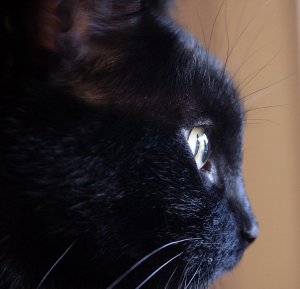Living with a blind cat
|
Some cats are born blind. Some will lose their sight due to illness or accident. Apart from injury, the most common causes of blindness in cats are Feline Glaucoma, Conjunctivitis in cats and Feline Progressive Retinal Atrophy. These can cause partial or total blindness and they are normally progressive. Glaucoma is a disease of the eye which is responsible for the blindness of most cats. It is caused by pressure within the eye caused by an imbalance between the production and drainage of aqueous humor. That is, the eye produces more fluid than it can drain away, and the resultant pressure on the eye causes blindness. Conjunctivitis, often called "pink-eye," is caused by a bacterium. |
It is extremely contagious, and difficult to treat. Symptoms are red, runny eyes and sometimes a discharge of pus. Progressive retinal atrophy (PRA) is in fact a group of very similar eye diseases. PRA causes no pain or discomfort but it can result in permanent blindness. 'Atrophy' means wasting away, which is what happens to the retina in this case. An early sign of PRA is that the cat loses one of its most distinctive features - the ability to see in dim light or at night. However, because PRA is a slow degenerative disease, and cats are very good at compensating for the loss of sight by orientating themselves with smell and sound, many owners are slow to realize that their pet is gradually becoming blind.
If a cat starts bumping into things or seems disorientated, it may be two things: the cat cannot see or can't coordinate its movements. If it is a visual problem, the blind eye is normally cloudy and dilated and the cat is unable to follow the direction of a light being moved past her face. A sudden loss of vision, for example after an accident, is more obvious because the cat has not had the chance to gradually adapt to the new condition. This may result in some behavioral problems. The cat may become withdrawn and scared, unwilling to go out or even leave the safety of its sleeping area. However, cats are both more adaptable and more stoical than most humans and they will soon start coming to terms with their loss of vision. Nor will blindness prevent them from happily getting on with life. Nevertheless, you can do your part to make life easier and safer.
Blind cats relay on scent, memory and spatial orientation to navigate. As long as the environment is constant they have little problem with that, but changes to their known environment confuses and upsets them. For example, if you decide to move her litter tray to somewhere new, a blind cat will have trouble finding it. The same applies to food and water bowls. Rearranging the furniture is also problematic for a blind cat. Not only will the cat start walking into chairs and tables, but these chairs and tables carry scent beacons which the cat navigates by. Cats mark their territory by rubbing their head and cheeks on the furniture, walls, and other household fittings. The rubbing releases a small amount of pheromone from the glands in the cat cheeks. With a sighted cat, these are territorial markers. With a blind cat, the scent of the different markers allows her to work out her position.

a cat does not experience the world only through its eyes
Likewise blind cats do not floors cluttered with temporary obstacles, such as rucksacks, carelessly discarded clothing or other unexpected obstacles. Access to the outdoors also becomes an issue; particularly when an outdoor cat becomes suddenly blind. Free roaming access to the outdoors is now impossible, not only because the outdoor environment is less controllable, but because of the danger of becoming the cat lost. If a cat explores beyond its territory smell no longer can guide her home. In this situation, a blind cat is both lost and terribly vulnerable. However, a blind cat need not always be an indoor cat. If possible, fence off part of the garden when the cat can be safe. If you can train the cat to use a harness or a lead, outdoor exercise can be enjoyable and safe. Remember that cats are free spirits and will resent over-protectiveness if it restricts their independence. Your cat might be safe, but she will not be happy. On the other hand, there are numerous reports of blind cats with access to outdoor enclosures which successfully hunt birds and small mammals by scent and hearing alone.
The indoor play should also be designed to stimulate cats other senses, especially smell and hearing. A ball rolling on the floor will not do much for a blind cats, but a ball with a little bell attached to it can now become an attractive toy. Scattering cat's favorite treats or biscuits on the floor will challenge her to find them by smell. Talk to the cat when you approach her so she can easily recognize the direction you are coming from. Although in truth, your voice is mainly for reassurance she will probably have heard your footsteps and already recognized them.
You may feel the urge to pick the cat up and carry her from one place to the next. Carrying her will help her to move safely from A to B, but it does the cat no favours. Studies have shown that cats are literally egocentric - they literally orientate the world in relation to themselves. So when you pick a blind cat and move to a new location, her whole navigation system becomes disrupted, resulting in a confused and stressed cat. If you do carry the cat, make sure the journey finishes somewhere that she can immediately map into her mental landscape, such as her bedding or litter tray. Do not put the cat on raised furniture unless she is familiar with where she is, e.g. her favorite chair. Otherwise she will probably fall straight off.
With cats as with humans, the onset of blindness can be a devastating psychological blow. Nevertheless cats are more than capable of adapting to a new lifestyle, and with a bit of consideration from their human, they can go on to enjoy happy and fulfilling lives.

